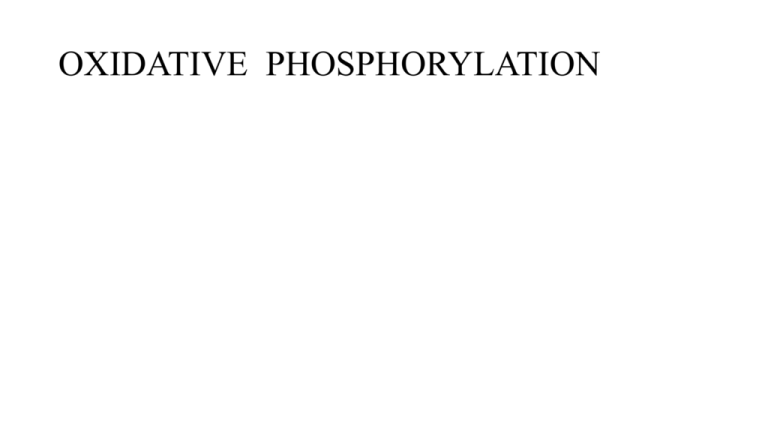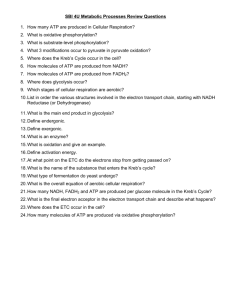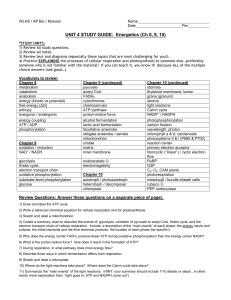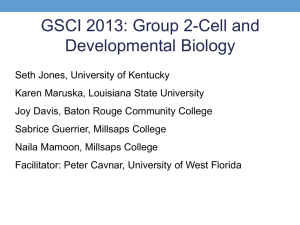Oxidative Phosphorylation
advertisement

OXIDATIVE PHOSPHORYLATION ATP is the single currency of life • Adenosine triphosphate • ATP is the most important molecule for capturing and transferring free energy • Hydrolysis of ATP to ADP + Pi yields 7.3 kcal/mol energy that can be used to power e.g. protein synthesis, muscle contraction or transport of molecules Oxidative phosphorylation generates ATP • In aerobic oxidation, sugars and fatty acids are metabolized to C02 and H20 . • The released energy is converted to chemical energy of phoshoanhydride bonds in ATP. Oxidative phosphorylation is the last stage of catabolism NADH and FADH2 NADH and FADH2 • Glycolysis, TCA cycle and fatty acid oxidation generate NADH and FADH2 • NADH and FADH2 are energy rich molecules because each contains a pair of electrons that have a high transfer potential • In oxidative phosphorylation the electon transferring potentila of NADH and FADH2 is converted to phosphate-transfer potential of ATP Mitochondrion Oxidative phosphorylation • ATP is formed as electrons are transferred from NADH or FADH2 to 02 by a series of electron carriers. Proton motive force and chemiosmotic coupling • The immediate energy sources that power ATP synthesis are proton gradient and electric potential (voltage gradient) across the membrane. • Proton gradient and electric potential are collectively called protonmotive force. Proton motive force and chemiosmotic coupling • The proton motive force is generated by stepwise movement of electrons by electron carriers that leads to pumping of protons out of the mitochondrial matrix. • Oxidation of NADH and phosphorylation of ADP are coupled by a generation of proton gradient. Proton motive force and chemiosmotic coupling Energy is released gradually in the electron transfer chain • Most free energy released when glucose is oxidised to carbon dioxide is retained in the reduced coenzymes NADH and FADH2 • Respiration: electrons are released from from NADH and FADH2 to oxygen • NADH + H+ + 1/2 02 = NAD+ +H20 Energy is released gradually in the electron transfer chain • NADH + H+ + 1/2 02 = NAD+ +H20 -52.6 kcal/mol • ADP + Pi = ATP +7.6 kcal/mol • ATP production is maximised by releasing the free energy in small increments in the electron transfer chain (a.k.a respiratory chain). • Electron transfer chain contains four multiprotein complexes. Three of these are electron driven proton pumps that create the proton gradient The electron transfer chain The electron transfer chain The electron transfer chain Electron transfer is driven by redox potential Redox potential • Oxidation-reduction potential • Oxidant + electron = reductant • Substance that can exist as a reduced and oxidices form is referred to a redox couple • Redox potential of such couple is measured against H+ -> H2 couple. • Redox potential of H+ -> H2 couple is defined as 0 V (volts). Redox potential • A negative redox potential means that a substance has lower affinity for electrons than hydrogen. Positive redox potential means higher affinity. • Strong oxidising agents have positive redox potential • In the respiratory chain the electrons are transferred to higher redox potential values, that is, to higher affinity electron carriers. Electron transfer is driven by redox potential Prosthetic groups act as electron carriers Complexes in the chain are transmembrane proteins Coenzyme Q and cytochrome c shuttle electrons Cytochromes are heme containing proteins • Cytochromes are covalently linked to heme, an iron-containing prosthetic group similar to that in hemoglobion or myoglobin. • Electron transport occurs by by oxidation and reduction of the Fe atom in the centre of the heme • Different cytochromes have slightly different heme groups that generate different ‘environment’ for Fe-ion and thus different tendency to accept an electron ATP Synthase ATP Synthase • ATP synthase or F0F1 complex has two components that are both itself multiprotein complexes • F0 is transmembrane complex that forms a regulated H+ channel • F1 is protrudes in the matrix and contains the sites for ATP formation ATP Synthase • Proton translocation through F0 powers rotation of one subunits of F1 • Three confromations, one binds ADP and Pi so tightly that they spontaneously form ATP. Several toxins can block oxidative phosphorylation Transporters traffic ATP and ADP Malate/aspartate shuttle and glycerol phosphate shuttle are needed for oxidation of cytosolic NADH Respiratory control • Mitochondria can only oxidise FADH and NADH only as long as there is ADP and Pi available. Electron flow ceases if ATP is not produced. • ADP increases when ATP is consumed e.g. in muscle work. Oxidative phosphorylation is regulated by ATP consumption. Brown-fat mitochondria contain an uncoupler of oxidative phosphorylation • Brown fat specialised to produce heat • Newborns: brown-fat thermogenesis • Thermogenin protein, a proton transporter that is not connected to ATP synthesis. • Energy released by NADH oxidation converted to heat. Oxidative Phosphorylation - Summary




